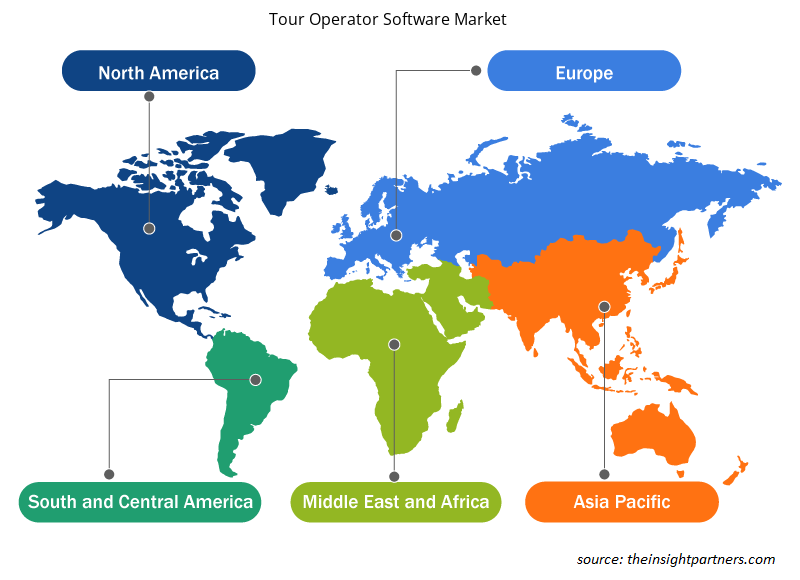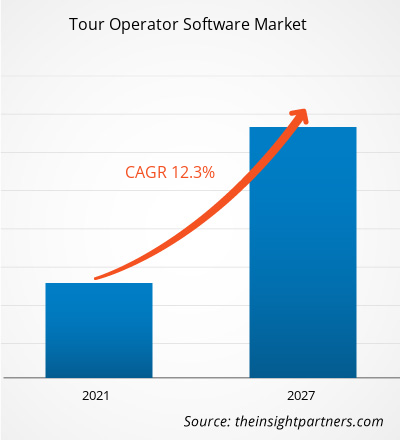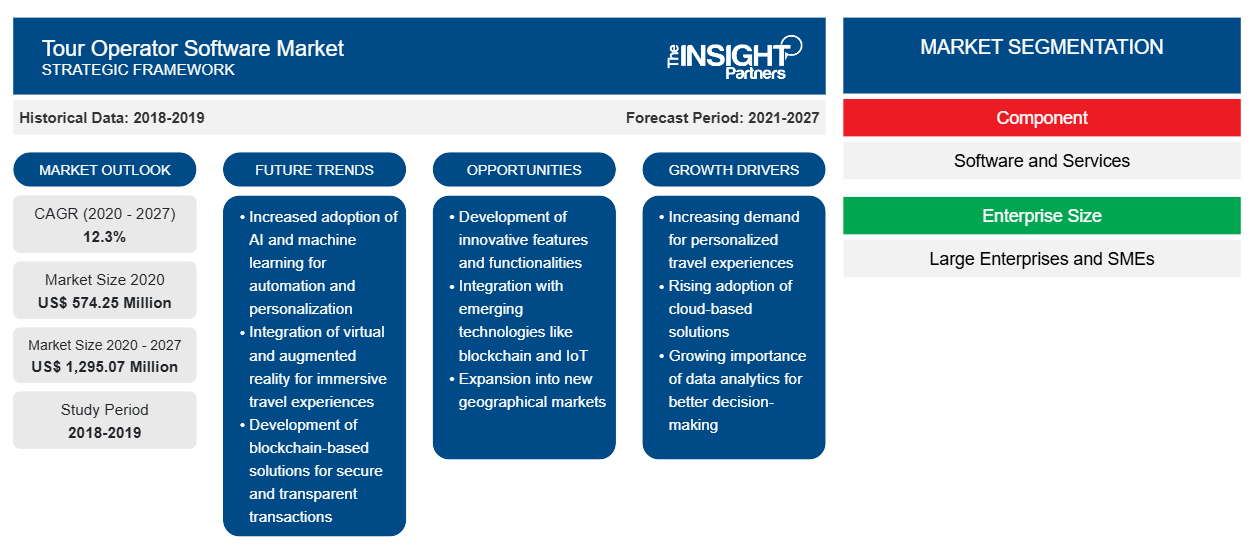Der Markt für Reiseveranstalter-Software dürfte von 574,25 Millionen US-Dollar im Jahr 2020 auf 1.295,07 Millionen US-Dollar im Jahr 2027 wachsen; von 2020 bis 2027 wird mit einer durchschnittlichen jährlichen Wachstumsrate von 12,3 % gerechnet.
Das Wachstum des Tourismussektors weltweit mit positiven Wirtschaftsaussichten trägt zum Wachstum des Marktes bei. Das Wachstum des Tourismussektors wird von Faktoren wie BIP-Wachstum, Wirtschaftsgröße, Entwicklung der Reiseinfrastruktur, Branchenmix, Bevölkerung und Regulierungspolitik beeinflusst. Diese Faktoren variieren von Land zu Land und wirken sich auf die Reiseinvestitionen in dem jeweiligen Land aus. Die Tourismusbranche hat im Laufe der Jahre einen enormen Aufschwung erlebt und wächst stetig. Die Nachfrage nach Tourismus in allen Gesellschaftsschichten hat zur Entstehung verschiedener Tourismusarten geführt, wie z. B. Straßentourismus, Wassertourismus und Lufttourismus, von denen der Straßentourismus die Branche lange Zeit dominiert hat. Das steigende verfügbare Einkommen der Massen in Industrie- und Entwicklungsländern hat dazu geführt, dass Reiseveranstalter ihre Reisen zunehmend buchen und sich für attraktive Angebote entscheiden. Darüber hinaus wird erwartet, dass das BIP-Wachstum in Entwicklungsländern wie China und Indien in den kommenden Jahren reichlich Möglichkeiten für das Marktwachstum bietet. Angesichts positiver globaler Wirtschaftsaussichten, Investitionen in die Reiseinfrastruktur, Wachstum bei KMU, enormen grenzüberschreitenden Handelsvolumina und stabilisierender politischer Bedingungen wird erwartet, dass die Ausgaben für den Tourismus in den nächsten Jahren weltweit steigen werden. Mit zunehmender Globalisierung und grenzüberschreitendem Handel steigen auch die Ausgaben für den Tourismus. Diese Faktoren haben sich positiv auf das Wachstum des Marktes für Reiseveranstalter-Software ausgewirkt.
Passen Sie diesen Bericht Ihren Anforderungen an
Sie erhalten kostenlos individuelle Anpassungen an jedem Bericht, einschließlich Teilen dieses Berichts oder einer Analyse auf Länderebene, eines Excel-Datenpakets sowie tolle Angebote und Rabatte für Start-ups und Universitäten.
-
Holen Sie sich die wichtigsten Markttrends aus diesem Bericht.Dieses KOSTENLOSE Beispiel umfasst eine Datenanalyse von Markttrends bis hin zu Schätzungen und Prognosen.
Auswirkungen der COVID-19-Pandemie auf den Markt für Reiseveranstalter-Software
Das Auftreten und die schnelle Verbreitung des Coronavirus (COVID-19) hat zahlreiche Länder, darunter Industrie- und Entwicklungsländer, lahmgelegt. Der kontinuierliche Anstieg der Zahl infizierter Patienten bedroht mehrere Branchen auf der ganzen Welt. Seit Dezember 2020 sind die Vereinigten Staaten, Indien, Brasilien, Russland und Frankreich einige der am schlimmsten betroffenen Länder in Bezug auf bestätigte Fälle und gemeldete Todesfälle. Der Ausbruch des Coronavirus hat aufgrund von Ausgangssperren, Reiseverboten und Geschäftsschließungen die Wirtschaft und Industrie in verschiedenen Ländern beeinträchtigt. Da die meisten Länder Ausgangssperren verhängen, hat dies negative Auswirkungen auf den Reise- und Tourismussektor. Die vorübergehenden Beschränkungen des Inlands- und Auslandsreisens durch die Regierung verschiedener Regionen zeigen ebenfalls einen negativen Trend im Tourismussektor. Die weitere Verbreitung von COVID-19 wäre für die Akteure auf dem Markt für Reiseveranstaltersoftware äußerst gefährlich .
Markteinblicke – Markt für Reiseveranstalter-Software
Zunehmende Einführung von KI im gesamten Tourismussektor
Die zunehmende Integration künstlicher Intelligenz (KI) zur Verbesserung des Gesamtprozesses der Buchung attraktiver Reisepakete durch Veranstalter fördert die Nutzung von Reiseveranstaltersoftware. Die Einführung von KI und Robotik in der Tourismusbranche steigert das Kundenerlebnis und die vom Reiseveranstalter angebotenen Dienstleistungen. Mit der Einführung künstlicher Reiseintelligenz werden die Reisevorbereitungen für die Passagiere weiter verbessert, um ihre Erwartungen zu erfüllen. Außerdem werden erstklassige Reisedienstleistungen angeboten, die individuell angepasst, automatisiert und aufschlussreich sind. Die Integration von KI ermöglicht es den Reiseveranstaltern, die Interessen und Verhaltensweisen der Reisenden zu untersuchen und ein verbessertes Erlebnis anzubieten. Die KI in der Reise- und Tourismusbranche konzentriert sich hauptsächlich auf die Kundenbindung und den Service, um das Reiseerlebnis der Reisenden weiter zu verbessern. Die aufkommenden KI-Technologien wie Chatbots, Sprachübersetzer und virtuelle Realität in den Tourismussektoren wirken sich positiv auf die Reise-, Tourismus- und Gastgewerbebranche aus. Somit stärkt die zunehmende Integration von KI den Tourismussektor weltweit weiter.
Komponentenbasierte Erkenntnisse
Basierend auf den Komponenten ist der Markt für Reiseveranstaltersoftware in Software und Dienstleistungen segmentiert. Das Softwaresegment hatte 2019 den größten Marktanteil.
Die Akteure auf dem Markt für Reiseveranstalter-Software konzentrieren sich hauptsächlich auf die Entwicklung fortschrittlicher und effizienter Produkte.
- Im Jahr 2020 haben GP Solutions GmbH und ComBtas eine strategische Partnerschaft geschlossen. Diese Allianz richtet sich an Kunden auf dem israelischen Markt. Mit dieser Zusammenarbeit würde ComBtas die schlüsselfertigen Produkte von GP Solutions, darunter GP Travel Enterprise und GP Travel Hub, fördern.
- Im Jahr 2020 hat Travefy, Inc. einen Website-Builder für Reiseberater auf den Markt gebracht. Mit dem Website-Builder können Berater Websites oder eine Marketing-Landingpage erstellen. Der Website-Builder verwendet eine Drag-and-Drop-Oberfläche, und Berater können ein Design auswählen, den Inhalt anpassen und benutzerdefinierte URLs verwenden. Darüber hinaus ist das Tool im Abonnementplan enthalten.
Regionale Einblicke in den Markt für Reiseveranstalter-Software
Die regionalen Trends und Faktoren, die den Markt für Reiseveranstalter-Software im Prognosezeitraum beeinflussen, wurden von den Analysten von Insight Partners ausführlich erläutert. In diesem Abschnitt werden auch Marktsegmente und Geografien für Reiseveranstalter-Software in Nordamerika, Europa, im asiatisch-pazifischen Raum, im Nahen Osten und Afrika sowie in Süd- und Mittelamerika erörtert.

- Erhalten Sie regionale Daten zum Markt für Reiseveranstalter-Software
Umfang des Marktberichts zur Reiseveranstalter-Software
| Berichtsattribut | Details |
|---|---|
| Marktgröße im Jahr 2020 | 574,25 Millionen US-Dollar |
| Marktgröße bis 2027 | 1.295,07 Millionen US-Dollar |
| Globale CAGR (2020 - 2027) | 12,3 % |
| Historische Daten | 2018-2019 |
| Prognosezeitraum | 2021-2027 |
| Abgedeckte Segmente |
Nach Komponente
|
| Abgedeckte Regionen und Länder |
Nordamerika
|
| Marktführer und wichtige Unternehmensprofile |
|
Dichte der Marktteilnehmer für Reiseveranstalter-Software: Die Auswirkungen auf die Geschäftsdynamik verstehen
Der Markt für Reiseveranstalter-Software wächst rasant, angetrieben durch die steigende Nachfrage der Endnutzer aufgrund von Faktoren wie sich entwickelnden Verbraucherpräferenzen, technologischen Fortschritten und einem größeren Bewusstsein für die Vorteile des Produkts. Mit steigender Nachfrage erweitern Unternehmen ihr Angebot, entwickeln Innovationen, um die Bedürfnisse der Verbraucher zu erfüllen, und nutzen neue Trends, was das Marktwachstum weiter ankurbelt.
Die Marktteilnehmerdichte bezieht sich auf die Verteilung der Firmen oder Unternehmen, die in einem bestimmten Markt oder einer bestimmten Branche tätig sind. Sie gibt an, wie viele Wettbewerber (Marktteilnehmer) in einem bestimmten Marktraum im Verhältnis zu seiner Größe oder seinem gesamten Marktwert präsent sind.
Die wichtigsten auf dem Markt für Reiseveranstalter-Software tätigen Unternehmen sind:
- Checkfront Inc
- GP Solutions GmbH
- Rezdy
- Tourenplan
- Travefy, Inc.
Haftungsausschluss : Die oben aufgeführten Unternehmen sind nicht in einer bestimmten Reihenfolge aufgeführt.

- Überblick über die wichtigsten Akteure auf dem Markt für Reiseveranstalter-Software
Der Markt für Reiseveranstalter-Software wurde wie folgt segmentiert:
Globaler Markt für Reiseveranstalter-Software – nach Komponenten
- Software
- Dienstleistungen
Globaler Markt für Reiseveranstalter-Software – nach Unternehmensgröße
- Große Unternehmen
- KMU
Globaler Markt für Reiseveranstalter-Software – nach Abonnementtyp
- Einmaliges Abonnement
- Monatliches Abonnement
- Jahresabonnement
Globaler Markt für Reiseveranstalter-Software – nach Geografie
-
Nordamerika
- UNS
- Kanada
- Mexiko
-
Europa
- Frankreich
- Deutschland
- Italien
- Russland
- Vereinigtes Königreich
- Restliches Europa
-
Asien-Pazifik (APAC)
- Japan
- China
- Australien
- Indien
- Südkorea
- Restlicher Asien-Pazifik-Raum
-
Naher Osten und Afrika (MEA)
- Saudi-Arabien
- Vereinigte Arabische Emirate
- Südafrika
- Rest von MEA
-
Südamerika (SAM)
- Brasilien
- Argentinien
- Rest von SAM
Markt für Reiseveranstalter-Software – Firmenprofile
- Checkfront Inc
- GP Solutions GmbH
- Rezdy
- Tourenplan
- Travefy, Inc.
- TraveloPro
- Trawex Technologies Pvt Ltd.
- TrekkSoft (TrekkSoft-Gruppe)
- TRYTN, Inc.
- Xola, Inc.
- Historische Analyse (2 Jahre), Basisjahr, Prognose (7 Jahre) mit CAGR
- PEST- und SWOT-Analyse
- Marktgröße Wert/Volumen – Global, Regional, Land
- Branchen- und Wettbewerbslandschaft
- Excel-Datensatz
Aktuelle Berichte
Verwandte Berichte
Erfahrungsberichte
Grund zum Kauf
- Fundierte Entscheidungsfindung
- Marktdynamik verstehen
- Wettbewerbsanalyse
- Kundeneinblicke
- Marktprognosen
- Risikominimierung
- Strategische Planung
- Investitionsbegründung
- Identifizierung neuer Märkte
- Verbesserung von Marketingstrategien
- Steigerung der Betriebseffizienz
- Anpassung an regulatorische Trends























 Kostenlose Probe anfordern für - Markt für Reiseveranstalter-Software
Kostenlose Probe anfordern für - Markt für Reiseveranstalter-Software